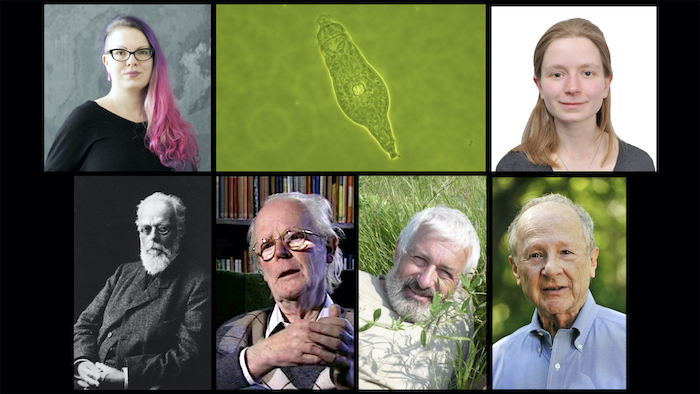Guest post by Charles H. Langley.
Dic, hospes, doctis caelebs animalculum obisse
hicque iacere physis legibus conveniens.
(Stranger, tell the learned that the celibate little animal has passed away, and lies here, conforming to the laws of nature.)
—John Rundin, with apologies to Simonides and Cicero
Thirty-five years ago, in a celebrated News & Views (1986) John Maynard Smith shared his well-developed thoughts about the evolutionary forces that may have maintained sex in the surviving lineages of eukaryotes. While parthenogenesis appears to be widespread, phylogenetic analyses were establishing that the overwhelming majority of the ancient and successful lineages retained sex in all its biological richness. Simple population genetic theory had long raised the question: what is the evolutionary mechanism(s) that overcomes that clear two-fold Malthusian advantage of an asexual mode of reproduction? After highlighting a number of interesting asexual species, Maynard Smith disposed of all of these as young and likely to be evolutionary dead ends. One hundred years earlier, before the rediscovery of Mendel and the development of population genetic foundations for natural selection Weismann (1887) had already surmised that natural selection favoring sexuality in multicellular organisms must be strong.
Maynard Smith cast the bdelloid rotifers as the exceptions, being perhaps 40 million years on the earth, and even after centuries of study these beloved and easily collected and cultured micro-animals had not yielded a male. Maynard Smith’s reference to the bdelloid as “something of an evolutionary scandal” energized efforts to address this assertion. Perhaps the early rotifers had evolved a creative evasion of the strong evolutionary forces maintaining sex in other eukaryotic lineages? Or were bdelloids simply ‘modest,’ pursuing sexual reproduction rarely and/or in the most obscure environments? Both these hypotheses appeared tenable, although the force of the first depends on negation of the latter.
Over the ensuing decades the natural history and systematics of bdelloids improved yet no evidence of sex emerged. Meanwhile molecular geneticist Matt Meselson and colleagues proceeded to look at the bdelloid genomes. Ancient duplications were discovered. And then Nowell et al. (2018) found evidence for the conservation in bdelloids of genes associated with meiosis throughout all eukaryotes. For unknown reasons, the simple inference of sex in the population genetics of bdelloid rotifer species was only recently addressed. Independently two research groups have now reported evidence of sex in the recent descent of distinct bdelloid species (Vakhrusheva et al. 2020) and (Laine et al. 2021). Variants at genomic locations far apart or on different chromosomes occur in combinations that strictly asexual reproduction precludes, but mere occasional sexual reproduction strongly predicts. They concluded that, despite the lack of observed mating or even of “males,” these bdelloid rotifers must have had recent sexual common ancestors. Thus the ‘scandal’ of evolutionary biology is transformed into the latest evidence driving what is perhaps the most significant and controversial question in evolutionary genetics, what force(s) maintains sex in eukaryotes.
The lifting of a scandal often engenders rectification of respect and the drawing of lessons, if not morals. The generality of the observed conservation of sex is, indeed, bolstered by the new evidence in bdelloid rotifer. It also raises other questions. Should the study of the reproductive biology of rotifers have been given tenfold more resources and talent? After all it took 35 years. Or can one suggest that this decisive evidence of bdelloid sexuality would have come in the same amount of time without the impetus of the ‘scandal?’
The real substance of Maynard Smith’s short discussion was, of course, the mechanism of the natural selection that maintained sex. The accepted competing hypotheses rest on the indirect selection induced by linkage among loci under selection. As R.A. Fisher and H.J. Muller noted in the 1930s, in the complete absence of sex, strongly favored rare variants (mutations) must arise and go to fixation in a sequential order. In contrast, sexual reproduction allows unlinked variants to respond to natural selection independently. Thus, sexual populations can more readily adapt to changing environments. And that’s what we observe, i.e., asexual lineages go extinct.
However, as H.J. Muller always wanted us to remember, the great majority of mutations are deleterious and much, if not most, of natural selection is committed to their eventual purging from the population. What Maynard Smith was at that time just beginning to appreciate and in the ensuing decades has become widely recognized, is that linkage also impedes this mode of natural selection. Thus, the selection on deleterious mutations can indirectly select in favor of sexual individuals and thereby maintain this most conserved of eukaryotic life history traits. Happily, the charming bdelloid now stands proudly at the center of inquiry into the evolutionary impact of natural selection.
Literature Cited
Laine V. N., T. Sackton, and M. Meselson, 2021 Genomic Signature of Sexual Reproduction in the Bdelloid Rotifer Macrotrachella quadricornifera. GENETICS https://doi.org/10.1093/genetics/iyab221
Maynard Smith J., 1986 Evolution: Contemplating life without sex. Nature 324: 300–301. https://doi.org/10.1038/324300a0
Nowell R. W., P. Almeida, C. G. Wilson, T. P. Smith, D. Fontaneto, A. Crisp, G. Micklem, A. Tunnacliffe, C. Boschetti, and T. G. Barraclough, 2018 Comparative genomics of bdelloid rotifers: Insights from desiccating and nondesiccating species, (C. Tyler-Smith, Ed.). PLOS Biol. 16: e2004830. https://doi.org/10.1371/journal.pbio.2004830
Vakhrusheva O. A., E. A. Mnatsakanova, Y. R. Galimov, T. V. Neretina, E. S. Gerasimov, S. A. Naumenko, S. G. Ozerova, A. O. Zalevsky, I. A. Yushenova, F. Rodriguez, I. R. Arkhipova, A. A. Penin, M. D. Logacheva, G. A. Bazykin, and A. S. Kondrashov, 2020 Genomic signatures of recombination in a natural population of the bdelloid rotifer Adineta vaga. Nat. Commun. 11: 6421. https://doi.org/10.1038/s41467-020-19614-y
Weismann A., 1887 On the signification of the polar globules. Nature. 36:607–609. https://doi.org/10.1038/036607a0
About the author:
Charles H. Langley is Distinguished Professor of Genetics at the University of California, Davis.































